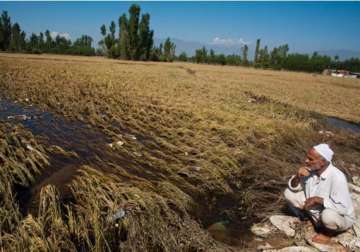Kashmir farmers' harvest battered by floods
Srinagar: Golden-brown autumn, the king of Kashmir's seasons, is plagued this year by the ravages of last month's unprecedented floods.As farmers battle to dry the flood-soaked grain and grass, there is ample evidence that the

Srinagar: Golden-brown autumn, the king of Kashmir's seasons, is plagued this year by the ravages of last month's unprecedented floods.
As farmers battle to dry the flood-soaked grain and grass, there is ample evidence that the scars left behind by the receding flood waters would not heal quickly.
"The paddy crop has suffered 70 percent to 80 percent damage in the Valley this year. Besides inundating paddy fields in south, central and north Kashmir when the crop was ripe and ready for harvest, grain production in areas where fields were not inundated has also suffered huge damage because of delayed harvesting", an agriculture department official told IANS.
Fruit growers had expected a bumper apple crop this season, but the ravaging of their orchards has left them shocked.
"This year the apple crop was good. The fruits had developed good colour and the trees laden with the fruits were waiting to be picked," Abdul Rashid, 52, an orchardist in north Kashmir's Goshbugh area of Baramulla district, told IANS.
"Floods devastated the orchards in our area. Believe it or not, I have seen many people going around in boats in their orchards to pick fruit and assess the damage to their trees," he added.
The rotting of paddy grass has resulted in a severe shortage of fodder for the cattle.
"A truckload of dry, paddy grass cost Rs.13,000 last year. Now it is difficult to get a truckload for even Rs.30,000. The winter is going to be miserable for our livestock. There simply isn't enough to feed them," Ghulam Ahmad Magray, 45, of north Kashmir's Ganderbal district, told IANS.
Areas in south Kashmir Anantnag, Pulwama and Kulgam districts are traditionally called the Valley's rice bowl.
These have been the worst affected by the floods so far as the agricultural damage is concerned.
The endless spread of golden-brown rice fields would sooth the eyes of the beholder and was also the pride of the farmer before the floods plundered the fields.
Today, the flood waters have receded, but the vast destruction they have wrought on the paddy fields is visible in the mud and slush left behind.
Floods had hit the paddy fields in the 1950s. Those who are still alive to tell that story give graphic accounts of the devastation.
"In 1958, floods hit our fields in the village. Nobody could reap an entire field after those floods. I remember some villagers would reap a patch and bring the wet grains home to dry it on the firewood-lit hearths.
"That was miserable. The government started free rations immediately after the 1958 floods; otherwise people in villages with little means to buy rice would have died of starvation", Ghulam Nabi, 72, of Saloora village in Ganderbal recalled while speaking to IANS.
Free rations for flood-affected areas have been started by the state government after the recent floods as well. But those who have seen the flood of 1958 and the recent one believe the devastation this time has been huge.
"In 1958 also paddy fields were devastated, but despite the crops in our area suffering less damage this year, the devastation in the south of the Valley has been catastrophic," said Ghulam Nabi.
Undoubtedly, the fortitude and resilience of the local farmers will ensure that they begin their agricultural operations with more vigour and resolve the next year, but the wounds and scars left behind by the 2014 floods will take long to heal.